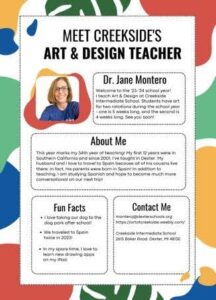
Dr. Montero’s welcome letter designed using Canva.
When summer starts to close in on August, I begin preparing Back-to-School “Welcome to Art” letters for parents and students. Each year, I focus on a new theme such as Cultivating Community (2022-2023) and Active Kindness (2023-2024), in the hopes of establishing a clear path for students as we navigate through the school year. Sometimes these themes mirror the whole school theme, as is the case with this year’s Active Kindness and Bee Kind. In fact, this year’s theme prompted a t-shirt design I created for school staff. I consider these practices to fall under the umbrella of advocacy. Advocacy for school climate. Advocacy for classroom environment. Advocacy for staff togetherness. However, what can we do to advocate specifically for art education? With many of us being the lone art teacher in our buildings, whether part of a small or larger school district, how can we bridge communication within our own districts to advocate for art education? And above all, what are we actually advocating for?
Identifying Needs

T-shirt design by Dr. Montero.
Over the years, there have been plenty of articles supporting the need for art education, with most of these articles linking increased academic achievement to a well-rounded curriculum, that includes the visual and performing arts. “The arts challenge us with different points of view, compel us to empathize with ‘others,’ and give us the opportunity to reflect on the human condition.” (Kisida & Bowen, 2019) We know the value of art education on our students. We see the joy in their eyes and hear the oohs and aahs of discovery; so, perhaps what we need to advocate for is more of these moments of joy. More art. More discovery. More time.
Advocacy Tips
Depending on your district and level of support for your art program, advocating may be easier said than done. So, here I offer advocacy tips to help guide the process. I organize these in order of easy to moderate to accelerated tips. I have practiced all of these approaches throughout my 34 years of teaching, with many becoming annual advocacy practices. The most important component to successful advocacy is to identify the person in your school building, or district office, who can become YOUR advocate and go-to person, to share what you are doing in the classroom. My ‘go to’ person is our district director of publicity. I send her news and images of art projects and events. She posts quick articles on our district social media pages and in quarterly news bulletins. Once you have that important person queued-up, you are good to go!
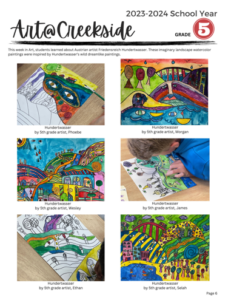
Example of newsletter created by Dr. Montero using Canva.
Easy Advocacy: Making student art work public.
Share as much of your students’ work as possible. Can you take photos and send them to your advocate? If you have a school parent organization, seek help in displaying art around the school. I realize this is a basic idea but given how little time many of us have to devote to putting up displays, finding a small, dedicated group of parents to help with this could save tons of time for you.
Example 1:
My building has a TV monitor in the front lobby. I asked who was in charge of the information displayed there and was given the person’s contact information (who happened to be one of our paraprofessionals). So, whenever students finish their art projects, I send her images for the monitor. The outcome from this simple act of advocacy is clear when students come into the art room saying, “Hey, I saw my art on the TV screen in the front lobby!”
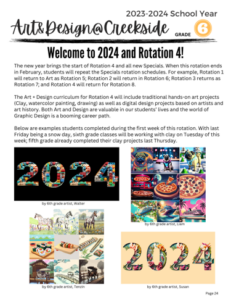 Example #2:
Example #2:
I asked my go-to advocate if our district had a dedicated public relations person, and, as a matter of fact, we do! So, I sent an email with a short paragraph of what students were doing in art class including a few photos, and she sent it on to the local newspaper. One of the reporters reached out to me for more information, which has led to an ongoing relationship promoting student art in our entire district.
Moderate Advocacy: Using free design apps.
With so many free design apps available online, creating social media posts, flyers for your school, quick certificates of participation, or sharing the latest art news has never been easier! My background is in traditional graphic design, so I took quickly to designing online using Canva, my favorite digital design tool. Canva is free for educators and students; however, follow your district guidelines on approved student use. Be aware of age restrictions being 13 and older, unless supervised by a parent or other approved adult (as in a teacher).
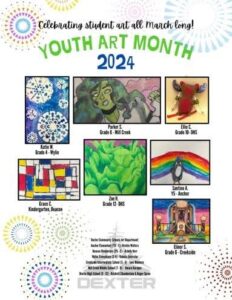 Example #1:
Example #1:
Designing Youth Art Month posters. Each year, I ask the art teachers in my district (we are a small, mighty group of seven), to send one image of student art to me for our annual Youth Art Month poster. This is a “win-win” because we each can share it in our own buildings, and also with our district PR person and local newspapers.
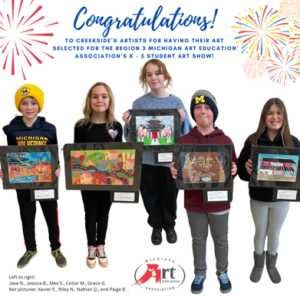
Youth Art Month student images and congratulations social media post created by Dr. Montero.
Example #2:
Creating flyers celebrating students! When we have student art prepared for our Regional Art Show, I snap a quick photo of each individual with their artwork. There is an excellent free app called remove.bg that works perfectly for getting rid of random backgrounds in order to create a group photo of students. This is especially helpful when students miss a photo opportunity, and you need to quickly add them into the group photo.
Accelerated Advocacy: Capturing the daily experience.
Don’t let this level scare you off from taking a deeper and more consistent dive into advocacy. I use this level to accelerate awareness of what’s happening in my art room on a continuing basis: maintaining communication via a weekly digital newsletter; digital flipbooks; and annual student art shows. One of the key reasons to maintain a newsletter is to keep shining a spotlight on our students. Art is a quiet activity, unlike marching bands, theatre, and dance. We look at art, we digest what we see, and we think about its meaning, therefore, we need to help bring it to the forefront.
Example #1:
Using Canva, I maintain a weekly digital newsletter that I share with my principal via a link and a QR code. The newsletter is also available via a digital flipbook. This newsletter serves several purposes:
- Students see their work highlighted.
- Parents see their child’s art in a public way.
- I have a running record of my entire school year.
This newsletter does require constant updating by me, but I have made it easy by copying and editing the same template over and over. Note: there are many free QR code generators online. Check out Bitly, QR code generator, or QR code monkey.
Example #2:

Dexter K-12 Art Walk display (photo by Dr. Montero).
Annual Art Shows. Yes, this is the biggie and planning for this annual event takes time and commitment. Several years ago, our district moved to what we named an ArtWalk, student art being displayed inside local businesses on Main Street. The show is open for three weeks during late April and May. Students love having their work selected for this show, and we typically have 30 -35 pieces per teacher in the district.
Advocacy Long Term
I have touched on what you can do in your school building, at the
local level, and districtwide to advocate and celebrate student art. There are many available resources on advocating at the state level and even at the national level. For example:
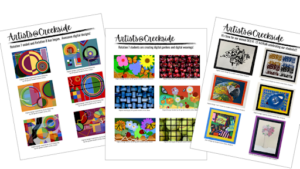
More newsletter examples.
- MAEIA invites Michigan districts, schools, organizations and businesses to join in addressing the goals of promoting student and professional learning and program improvement in arts education by becoming a MAEIA Partner or Affiliate.
- Michigan’s vibrant arts and cultural scene are important to the state’s communities, excellent quality-of-life and thriving economy. Michigan Arts and Culture Council is the state’s key conduit for arts and cultural information, grant funding and more.
- The Arts Education Partnership is a national network of more than 200 organizations dedicated to advancing arts education. AEP has been supported by the National Endowment for the Arts and the U.S. Department of Education since 1995 and is administered by Education Commission of the States. AEP is the nation’s hub for arts and education leaders, building their leadership capacity to support students, educators and learning environments.
- The National Art Education Association states on their website, “Arts education is recognized as an important part of every learner’s education, and ongoing efforts have been made to identify and promote the benefits of the arts.”
Advocacy is a key ingredient for successful teaching and for establishing a known arts education program in your school district. With so many useful strategies and helpful tools online, advocacy need not be a burden. Developing a group of colleagues and collaborators makes the job of advocacy easier, whether your advocacy efforts include school staff members, personnel from the district office, and/or parents in your community. Advocacy is ultimately about celebrating your students, and this in itself builds connections between you and your students that last a lifetime. I hope you will give the above advocacy tips a try!
___________________________________________________________________________________________________________
 Jane Montero is a 5th/6th grade art teacher at Creekside Intermediate School in Dexter, MI. She has taught middle level art for 34 years and is a graduate of National Art Education Association’s School for Art Leaders in 2019. Jane earned her Doctor of Education in Leadership and Innovation in 2021. She currently serves as President for the MAEA and is also the MAEA Representative for the MAEIA Partners. In 2023, Jane received the Outstanding Teaching award from NAEA’s Art Media Technology Interest Group and was Michigan’s Middle Level Art Educator of the Year and National Middle Level Art Educator of the Year, 2021-22.
Jane Montero is a 5th/6th grade art teacher at Creekside Intermediate School in Dexter, MI. She has taught middle level art for 34 years and is a graduate of National Art Education Association’s School for Art Leaders in 2019. Jane earned her Doctor of Education in Leadership and Innovation in 2021. She currently serves as President for the MAEA and is also the MAEA Representative for the MAEIA Partners. In 2023, Jane received the Outstanding Teaching award from NAEA’s Art Media Technology Interest Group and was Michigan’s Middle Level Art Educator of the Year and National Middle Level Art Educator of the Year, 2021-22.
References
Kisida, B., & Bowen, D. (2019, February 19). New Evidence of Art Education. Brookings. https://www.brookings.edu/articles/new-evidence-of-the-benefits-of-arts-education/
National Art Education Association (2024). www.arteducators.org
Yang, R. (2023, November 13). Art Education Advocacy Resources. NAEA. https://www.arteducators.org/community/articles/1205-advocacy-column-winter-2023
Images provided by the author.
Click here for a Printer friendly version of this article.
Leave a Reply
You must be logged in to post a comment. Don't have an account? Register Here.